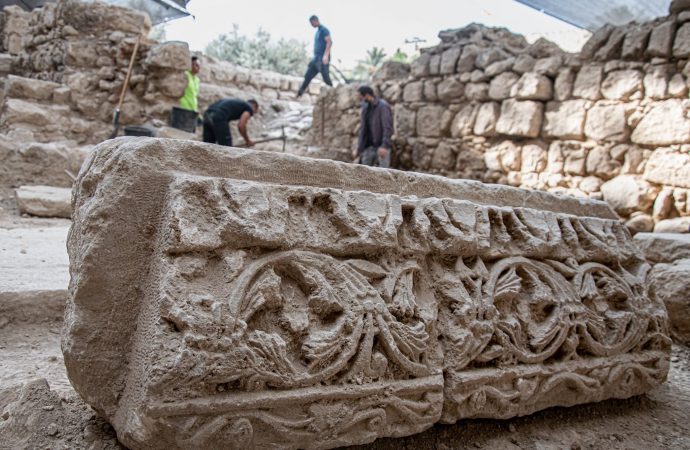
By Charles Collins
(CRUX) — A ritual bath dating to the time of Jesus has been uncovered on the Mount of Olives at the site tradition says is the Garden of Gethsemane, where Jesus experienced the Agony in the Garden before his arrest, trial, and crucifixion.
Gethsemane means “oil press” in Hebrew, which archeologists said might explain the find.
“According to the Jewish law, when you are producing wine or olive oil, you need to be purified,” said Amit Re’em of the Israel Antiquities Authority during a press conference on Dec. 21.
“So, there is a high probability that during the time of Jesus, at this place was an oil press,” he said.
Re’em said this was the first archeological evidence linking the site to the biblical story that made it famous.
“Despite there being several excavations in the place since 1919 and beyond, and that there were several findings — from the Byzantine and Crusader eras, and others — there has not been one piece of evidence from the time of Jesus. Nothing! And then, as an archaeologist, there arises the question: Is there evidence of the New Testament story, or maybe it happened elsewhere?” he told the “Times of Israel.”

The archeologist said that ritual baths are not uncommon to find in Israel, but finding one in the middle of a field implicitly means it was used for ritual purity purposes in the context of agriculture.
“Most of the ritual baths of the period of the Second Temple have been found in private homes and public buildings, but some have been discovered close to farms and tombs, in which case the ritual bath is outside. The discovery of this bath, not accompanied by buildings, probably attests to the existence of a farm here 2000 years ago, which perhaps produced oil or wine,” Re’em said.
The find was made during the construction of a tunnel linking the Church of Gethsemane – also known as the Church of the Agony or Church of All Nations – to a new visitors’ center.
The church is run by the Franciscan Custody of the Holy Land, and the excavation was carried out jointly by the Israel Antiquities Authority and students from the Studium Biblicum Franciscanum.
The current basilica was built between 1919 and 1924, and contains the stone that Judas allegedly prayed on before his arrest after his betrayal of Jesus. When it was built, the remains of churches from the Byzantine and Crusader periods were discovered.
Photo of the excavation of a Byzantine Church in the Garden of Gethsemane carried out jointly by the Israel Antiquities Authority and students from the Studium Biblicum Franciscanum. (Photo: Yaniv Berman/Courtesy of the Israel Antiquities Authority)
However, during the newest excavations, the remains of a previously unknown 6th century church was discovered, which was used until at least the 8th century. Made up of a stone floor, the church had a semi-circular apse paved with a mosaic featuring a flower pattern.
“At the center there must have been an altar of which no traces have been found. A Greek inscription, still visible today and which can be dated to the 7th-8th century AD is from a later period,” said Franciscan Father Eugenio Alliata.
The inscription read: “For the memory and repose of the lovers of Christ (cross) God who have received the sacrifice of Abraham, accept the offering of your servants and give them remission of sins. (cross) Amen.”
The archeologists also found the remains of a large medieval hospice or monastery next to the Byzantine church. The structure had a sophisticated plumbing system and two large tanks six or seven meters deep, adorned with crosses.
David Yeger of the Israel Antiquities Authority said the discovery showed that Christians were coming to the Holy Land even under Muslim rule.
“It is interesting to see that the church was being used, and may even have been founded, at the time when Jerusalem was under Muslim rule, showing that Christian pilgrimages to Jerusalem continued during this period as well,” he said.
Re’em said the structure was likely destroyed in 1187, when the local Muslim ruler razed the churches on the Mount of Olives to provide material to fortify the city walls.
Franciscan Father Francesco Patton, the head of the Franciscan Custody of the Holy Land, said the excavations “confirm the ancient nature of the Christian memory and tradition linked with this site.”
Franciscan Father Francesco Patton, Custos of the Holy Land, next to the ancient ritual bath. (Photo: Yoli Schwartz/Israel Antiquities Authority.)
During the press conference, he said Gethsemane is a place of prayer, of violence, and of reconciliation.
“It is a place of prayer because here Jesus would come to pray, and it is the place where he also prayed after the last supper with his disciples just before he was arrested. In this place millions of pilgrims every year stop to pray in order to learn and to place their will in tune with the will of God. This is also a place of violence, since here Jesus was betrayed and arrested. Finally, it is a place of reconciliation, because here Jesus refused to make use of violence in order to react to his unjust arrest,” Fr. Patton said.
Re’em said the excavation at Gethsemane is “a prime example of Jerusalem’s archaeology at its best, in which various traditions and beliefs are combined with archaeology and historical evidence.”
“The recently discovered archaeological remains will be incorporated in the visitors’ center being built at the site and will be exhibited to tourists and pilgrims, who we hope will soon be returning to visit Jerusalem,” the archeologist said.



Nice historical account. A site worth visiting, the sooner the better.